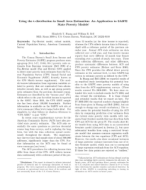
An official website of the United States government
Here’s how you know
Official websites use .gov
A .gov website belongs to an official government organization in the United States.
Secure .gov websites use HTTPS
A lock (
) or https:// means you’ve safely connected to the .gov website. Share sensitive information only on official, secure websites.
-
//
- Census.gov /
- Library /
- Census Working Papers /
- Using the t-distribution in Small Area Estimation
Using the t-distribution in Small Area Estimation: An Application to SAIPE State Poverty Models
Using the t-distribution in Small Area Estimation: An Application to SAIPE State Poverty Models
Introduction
The Census Bureau’s Small Area Income and Poverty Estimates (SAIPE) program produces state age-group (0-4, 5-17, 18-64, 65+) poverty ratio estimates from Bayesian treatment (Bell 1999) of a Fay-Herriot model (Fay and Herriot 1979) applied to direct state poverty ratio estimates from the Current Population Survey (CPS) Annual Social and Economic Supplement (ASEC, formerly known as the CPS March income supplement). The models borrow information from regression variables related to poverty that are constructed from administrative records data, as well as age group poverty ratio estimates from the previous decennial census. Estimates are identified by the “income year” (IY), which refers to the year for which income is reported in the ASEC. Since 2001, the CPS ASEC sample size has been about 100,000 households.
Share
Related Information
Some content on this site is available in several different electronic formats. Some of the files may require a plug-in or additional software to view.
 Yes
Yes
 No
NoComments or suggestions?


Top

